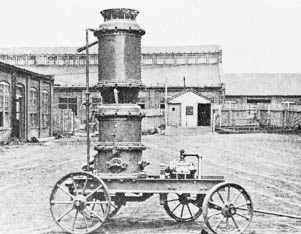Carl Ethan Akeley
Carl Ethan Akeley (born May 19, 1864 in Clarendon , New York , † November 18, 1926 in Belgian Congo ) was an American hunter, taxidermist , naturalist, professor, artist and inventor. Akeley received more than 30 patents for his inventions.
Life
In 1886 he began working and researching as a taxidermist at the Milwaukee Public Museum and later at the Field Museum of Natural History . He specialized in African mammals, especially gorillas and elephants.
In 1902 he married the naturalist Delia Akeley . Together they went on several expeditions to Africa. In 1909 Akeley took part in an expedition from Theodore Roosevelt to Africa. In the following years he made numerous other trips and studied gorillas in particular. His commitment to species conservation resulted from these expeditions . He campaigned for the establishment of the Albert National Park , the first nature reserve in Africa.
Carl Ethan Akeley was also known as an artist. Most of his sculptures, some of which are on display at the American Museum of Natural History , depict animals.
In 1924 Carl and Delia Akeley divorced. Akeley married the researcher Mary Jobe Akeley that same year . In 1926 they went on an expedition to what was then the colony of Belgian Congo , where they researched and photographed animals and plants on behalf of the American Museum of Natural History . When Carl Akeley died unexpectedly in 1926, Mary Jobe Akeley took over the leadership of the expedition and continued his research. Mary Jobe Akeley later published several books on these trips.
Akeley himself published, among other things, an autobiography entitled In Brightest Africa ( In Brightest Africa ). He died of a fever during his fifth expedition to Africa in the Congo and is buried only a few kilometers from the place where he first encountered the gorilla "Old Man of Mikeno". A room in the American Museum of Natural History is named after him in his honor.
Invention of shotcrete
His best-known invention is the spray mortar or shotcrete , which he invented at the beginning of the 20th century and for which he received a patent in 1911 (patent application 1908 as "apparatus for mixing and applying plastic materials"). In the beginning he was looking for a method of making plastic models of large animals during his preparation work. To do this, he built a wire frame, and with a special cannon he sprayed mortar onto the wire with compressed air. First he made models of animals for museum exhibitions with his cement cannon for the Field Museum of Natural History in Chicago , and later he also used this method on buildings.
Works (selection)
- In the brightest Africa. Publishing house August Scherl, 1925.
- with Mary Lenore Jobe Akeley: Adventures in the African jungle. Dodd, Mead & Company, 1930.
- with Mary Lenore Jobe Akeley: Lions, gorillas and their neighbors. Dodd, Mead & Company, 1932.
Web links
- Literature by and about Akeley
- Akeley in the midst of his preparations (photo)
- Biography in Edward Porter Alexander: The Museum in America: Innovators and Pioneers. Alta Mira 1997, ISBN 0-7619-8946-3 .
- Akeley Hall of African Mammals in the American Museum of Natural History
| personal data | |
|---|---|
| SURNAME | Akeley, Carl Ethan |
| BRIEF DESCRIPTION | American hunter, taxidermist, naturalist, professor, artist, and inventor |
| DATE OF BIRTH | May 19, 1864 |
| PLACE OF BIRTH | Clarendon , New York |
| DATE OF DEATH | November 18, 1926 |
| Place of death | Belgian Congo |

